Lei Ding
S2C: Learning Noise-Resistant Differences for Unsupervised Change Detection in Multimodal Remote Sensing Images
Feb 18, 2025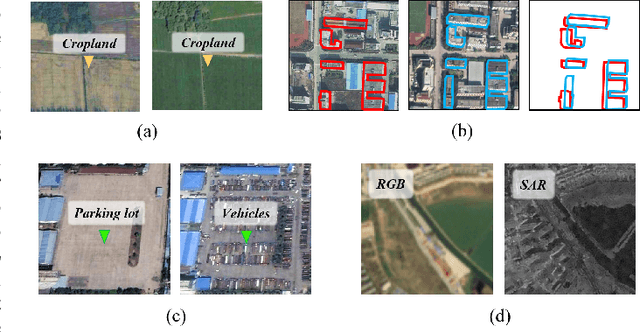
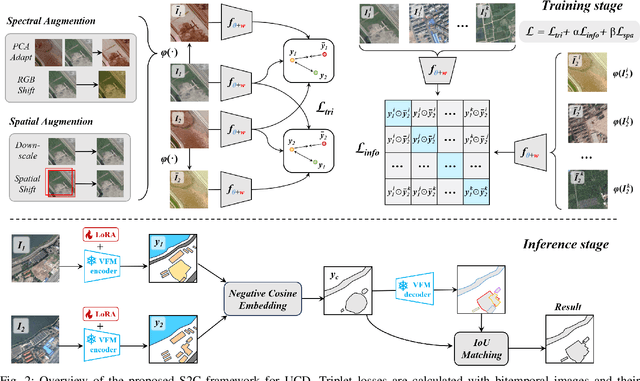


Abstract:Unsupervised Change Detection (UCD) in multimodal Remote Sensing (RS) images remains a difficult challenge due to the inherent spatio-temporal complexity within data, and the heterogeneity arising from different imaging sensors. Inspired by recent advancements in Visual Foundation Models (VFMs) and Contrastive Learning (CL) methodologies, this research aims to develop CL methodologies to translate implicit knowledge in VFM into change representations, thus eliminating the need for explicit supervision. To this end, we introduce a Semantic-to-Change (S2C) learning framework for UCD in both homogeneous and multimodal RS images. Differently from existing CL methodologies that typically focus on learning multi-temporal similarities, we introduce a novel triplet learning strategy that explicitly models temporal differences, which are crucial to the CD task. Furthermore, random spatial and spectral perturbations are introduced during the training to enhance robustness to temporal noise. In addition, a grid sparsity regularization is defined to suppress insignificant changes, and an IoU-matching algorithm is developed to refine the CD results. Experiments on four benchmark CD datasets demonstrate that the proposed S2C learning framework achieves significant improvements in accuracy, surpassing current state-of-the-art by over 31\%, 9\%, 23\%, and 15\%, respectively. It also demonstrates robustness and sample efficiency, suitable for training and adaptation of various Visual Foundation Models (VFMs) or backbone neural networks. The relevant code will be available at: github.com/DingLei14/S2C.
A Survey of Sample-Efficient Deep Learning for Change Detection in Remote Sensing: Tasks, Strategies, and Challenges
Feb 05, 2025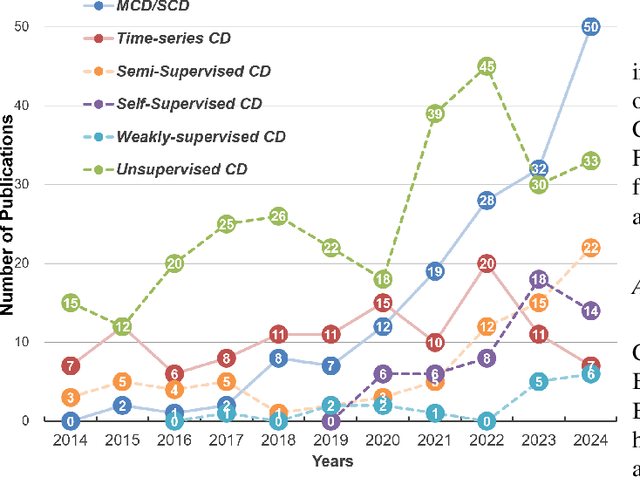
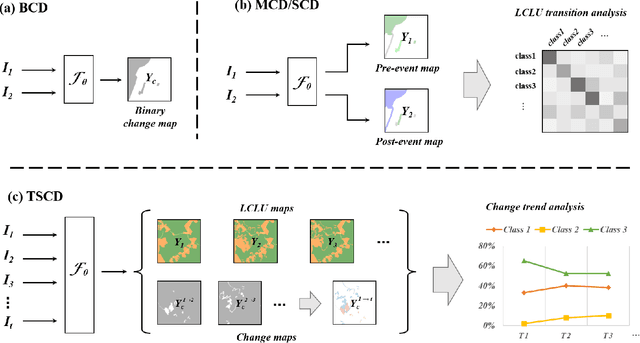
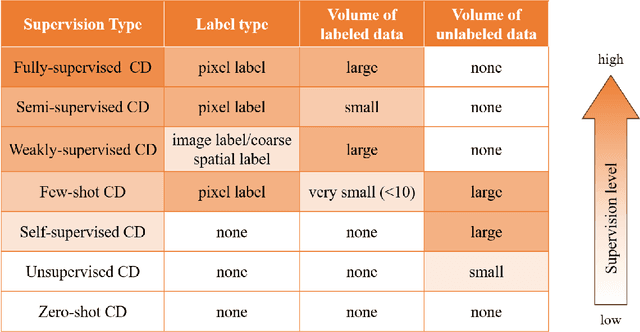
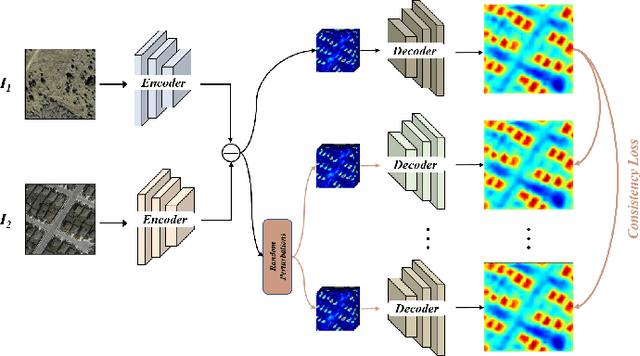
Abstract:In the last decade, the rapid development of deep learning (DL) has made it possible to perform automatic, accurate, and robust Change Detection (CD) on large volumes of Remote Sensing Images (RSIs). However, despite advances in CD methods, their practical application in real-world contexts remains limited due to the diverse input data and the applicational context. For example, the collected RSIs can be time-series observations, and more informative results are required to indicate the time of change or the specific change category. Moreover, training a Deep Neural Network (DNN) requires a massive amount of training samples, whereas in many cases these samples are difficult to collect. To address these challenges, various specific CD methods have been developed considering different application scenarios and training resources. Additionally, recent advancements in image generation, self-supervision, and visual foundation models (VFMs) have opened up new approaches to address the 'data-hungry' issue of DL-based CD. The development of these methods in broader application scenarios requires further investigation and discussion. Therefore, this article summarizes the literature methods for different CD tasks and the available strategies and techniques to train and deploy DL-based CD methods in sample-limited scenarios. We expect that this survey can provide new insights and inspiration for researchers in this field to develop more effective CD methods that can be applied in a wider range of contexts.
Right this way: Can VLMs Guide Us to See More to Answer Questions?
Nov 01, 2024



Abstract:In question-answering scenarios, humans can assess whether the available information is sufficient and seek additional information if necessary, rather than providing a forced answer. In contrast, Vision Language Models (VLMs) typically generate direct, one-shot responses without evaluating the sufficiency of the information. To investigate this gap, we identify a critical and challenging task in the Visual Question Answering (VQA) scenario: can VLMs indicate how to adjust an image when the visual information is insufficient to answer a question? This capability is especially valuable for assisting visually impaired individuals who often need guidance to capture images correctly. To evaluate this capability of current VLMs, we introduce a human-labeled dataset as a benchmark for this task. Additionally, we present an automated framework that generates synthetic training data by simulating ``where to know'' scenarios. Our empirical results show significant performance improvements in mainstream VLMs when fine-tuned with this synthetic data. This study demonstrates the potential to narrow the gap between information assessment and acquisition in VLMs, bringing their performance closer to humans.
Dual-Model Distillation for Efficient Action Classification with Hybrid Edge-Cloud Solution
Oct 16, 2024Abstract:As Artificial Intelligence models, such as Large Video-Language models (VLMs), grow in size, their deployment in real-world applications becomes increasingly challenging due to hardware limitations and computational costs. To address this, we design a hybrid edge-cloud solution that leverages the efficiency of smaller models for local processing while deferring to larger, more accurate cloud-based models when necessary. Specifically, we propose a novel unsupervised data generation method, Dual-Model Distillation (DMD), to train a lightweight switcher model that can predict when the edge model's output is uncertain and selectively offload inference to the large model in the cloud. Experimental results on the action classification task show that our framework not only requires less computational overhead, but also improves accuracy compared to using a large model alone. Our framework provides a scalable and adaptable solution for action classification in resource-constrained environments, with potential applications beyond healthcare. Noteworthy, while DMD-generated data is used for optimizing performance and resource usage in our pipeline, we expect the concept of DMD to further support future research on knowledge alignment across multiple models.
SoftDedup: an Efficient Data Reweighting Method for Speeding Up Language Model Pre-training
Jul 09, 2024
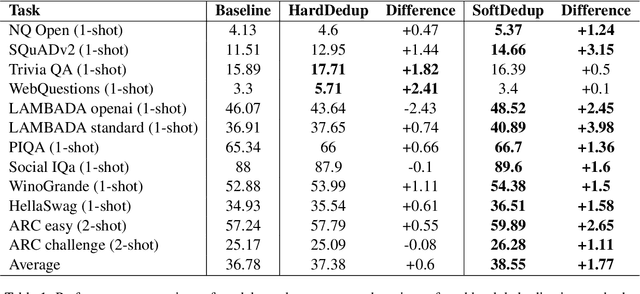
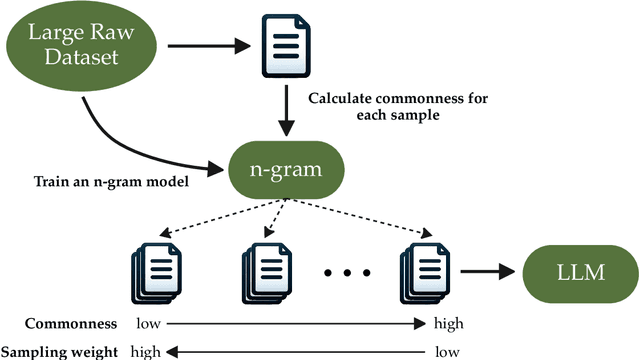
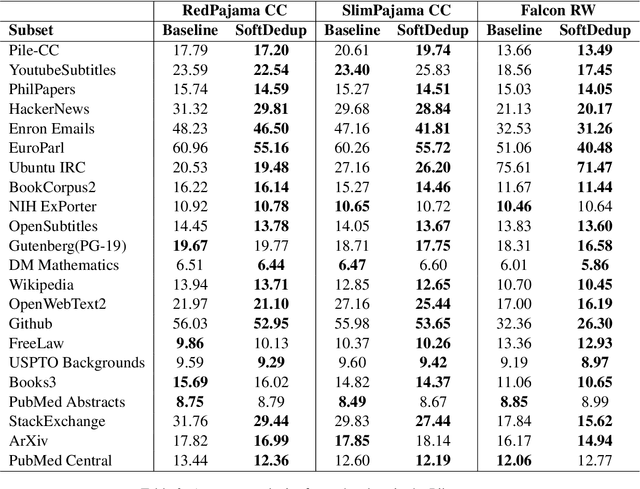
Abstract:The effectiveness of large language models (LLMs) is often hindered by duplicated data in their extensive pre-training datasets. Current approaches primarily focus on detecting and removing duplicates, which risks the loss of valuable information and neglects the varying degrees of duplication. To address this, we propose a soft deduplication method that maintains dataset integrity while selectively reducing the sampling weight of data with high commonness. Central to our approach is the concept of "data commonness", a metric we introduce to quantify the degree of duplication by measuring the occurrence probabilities of samples using an n-gram model. Empirical analysis shows that this method significantly improves training efficiency, achieving comparable perplexity scores with at least a 26% reduction in required training steps. Additionally, it enhances average few-shot downstream accuracy by 1.77% when trained for an equivalent duration. Importantly, this approach consistently improves performance, even on rigorously deduplicated datasets, indicating its potential to complement existing methods and become a standard pre-training process for LLMs.
Read Anywhere Pointed: Layout-aware GUI Screen Reading with Tree-of-Lens Grounding
Jun 27, 2024



Abstract:Graphical User Interfaces (GUIs) are central to our interaction with digital devices. Recently, growing efforts have been made to build models for various GUI understanding tasks. However, these efforts largely overlook an important GUI-referring task: screen reading based on user-indicated points, which we name the Screen Point-and-Read (SPR) task. This task is predominantly handled by rigid accessible screen reading tools, in great need of new models driven by advancements in Multimodal Large Language Models (MLLMs). In this paper, we propose a Tree-of-Lens (ToL) agent, utilizing a novel ToL grounding mechanism, to address the SPR task. Based on the input point coordinate and the corresponding GUI screenshot, our ToL agent constructs a Hierarchical Layout Tree. Based on the tree, our ToL agent not only comprehends the content of the indicated area but also articulates the layout and spatial relationships between elements. Such layout information is crucial for accurately interpreting information on the screen, distinguishing our ToL agent from other screen reading tools. We also thoroughly evaluate the ToL agent against other baselines on a newly proposed SPR benchmark, which includes GUIs from mobile, web, and operating systems. Last but not least, we test the ToL agent on mobile GUI navigation tasks, demonstrating its utility in identifying incorrect actions along the path of agent execution trajectories. Code and data: screen-point-and-read.github.io
Improving Technical "How-to" Query Accuracy with Automated Search Results Verification and Reranking
Apr 13, 2024Abstract:Many people use search engines to find online guidance to solve computer or mobile device problems. Users frequently encounter challenges in identifying effective solutions from search results, often wasting time trying ineffective solutions that seem relevant yet fail to solve the real problems. This paper introduces a novel approach to improving the accuracy and relevance of online technical support search results through automated search results verification and reranking. Taking "How-to" queries specific to on-device execution as a starting point, we first developed a solution that allows an AI agent to interpret and execute step-by-step instructions in the search results in a controlled Android environment. We further integrated the agent's findings into a reranking mechanism that orders search results based on the success indicators of the tested solutions. The paper details the architecture of our solution and a comprehensive evaluation of the system through a series of tests across various application domains. The results demonstrate a significant improvement in the quality and reliability of the top-ranked results. Our findings suggest a paradigm shift in how search engine ranking for online technical support help can be optimized, offering a scalable and automated solution to the pervasive challenge of finding effective and reliable online help.
A Survey on Human-AI Teaming with Large Pre-Trained Models
Mar 07, 2024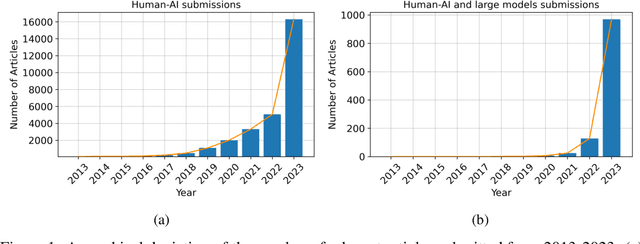
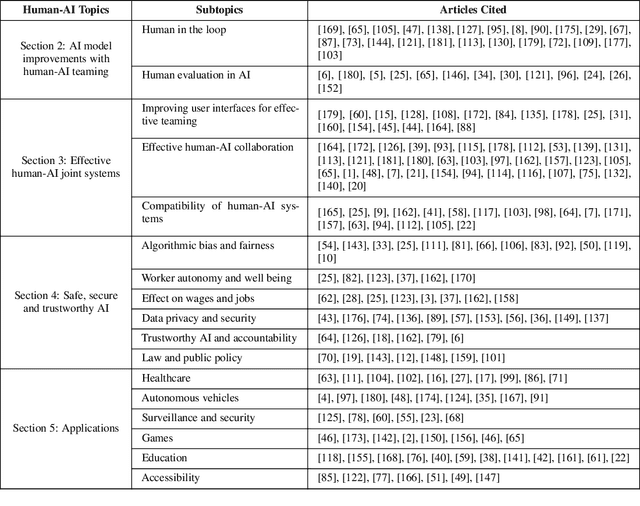
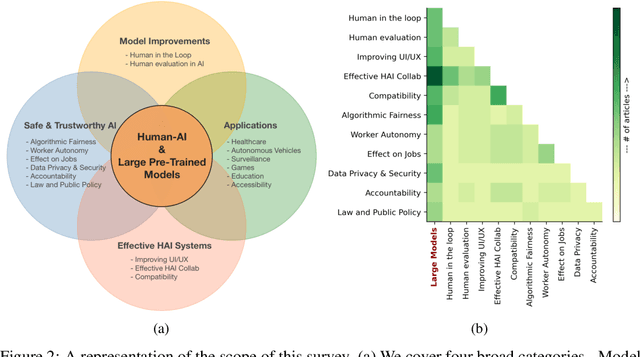
Abstract:In the rapidly evolving landscape of artificial intelligence (AI), the collaboration between human intelligence and AI systems, known as Human-AI (HAI) Teaming, has emerged as a cornerstone for advancing problem-solving and decision-making processes. The advent of Large Pre-trained Models (LPtM) has significantly transformed this landscape, offering unprecedented capabilities by leveraging vast amounts of data to understand and predict complex patterns. This paper surveys the pivotal integration of LPtMs with HAI, emphasizing how these models enhance collaborative intelligence beyond traditional approaches. It examines the synergistic potential of LPtMs in augmenting human capabilities, discussing this collaboration for AI model improvements, effective teaming, ethical considerations, and their broad applied implications in various sectors. Through this exploration, the study sheds light on the transformative impact of LPtM-enhanced HAI Teaming, providing insights for future research, policy development, and strategic implementations aimed at harnessing the full potential of this collaboration for research and societal benefit.
Gaussian Differential Privacy on Riemannian Manifolds
Nov 09, 2023
Abstract:We develop an advanced approach for extending Gaussian Differential Privacy (GDP) to general Riemannian manifolds. The concept of GDP stands out as a prominent privacy definition that strongly warrants extension to manifold settings, due to its central limit properties. By harnessing the power of the renowned Bishop-Gromov theorem in geometric analysis, we propose a Riemannian Gaussian distribution that integrates the Riemannian distance, allowing us to achieve GDP in Riemannian manifolds with bounded Ricci curvature. To the best of our knowledge, this work marks the first instance of extending the GDP framework to accommodate general Riemannian manifolds, encompassing curved spaces, and circumventing the reliance on tangent space summaries. We provide a simple algorithm to evaluate the privacy budget $\mu$ on any one-dimensional manifold and introduce a versatile Markov Chain Monte Carlo (MCMC)-based algorithm to calculate $\mu$ on any Riemannian manifold with constant curvature. Through simulations on one of the most prevalent manifolds in statistics, the unit sphere $S^d$, we demonstrate the superior utility of our Riemannian Gaussian mechanism in comparison to the previously proposed Riemannian Laplace mechanism for implementing GDP.
Temporal compressive edge imaging enabled by a lensless diffuser camera
Sep 13, 2023Abstract:Lensless imagers based on diffusers or encoding masks enable high-dimensional imaging from a single shot measurement and have been applied in various applications. However, to further extract image information such as edge detection, conventional post-processing filtering operations are needed after the reconstruction of the original object images in the diffuser imaging systems. Here, we present the concept of a temporal compressive edge detection method based on a lensless diffuser camera, which can directly recover a time sequence of edge images of a moving object from a single-shot measurement, without further post-processing steps. Our approach provides higher image quality during edge detection, compared with the conventional post-processing method. We demonstrate the effectiveness of this approach by both numerical simulation and experiments. The proof-of-concept approach can be further developed with other image post-process operations or versatile computer vision assignments toward task-oriented intelligent lensless imaging systems.
 Add to Chrome
Add to Chrome Add to Firefox
Add to Firefox Add to Edge
Add to Edge